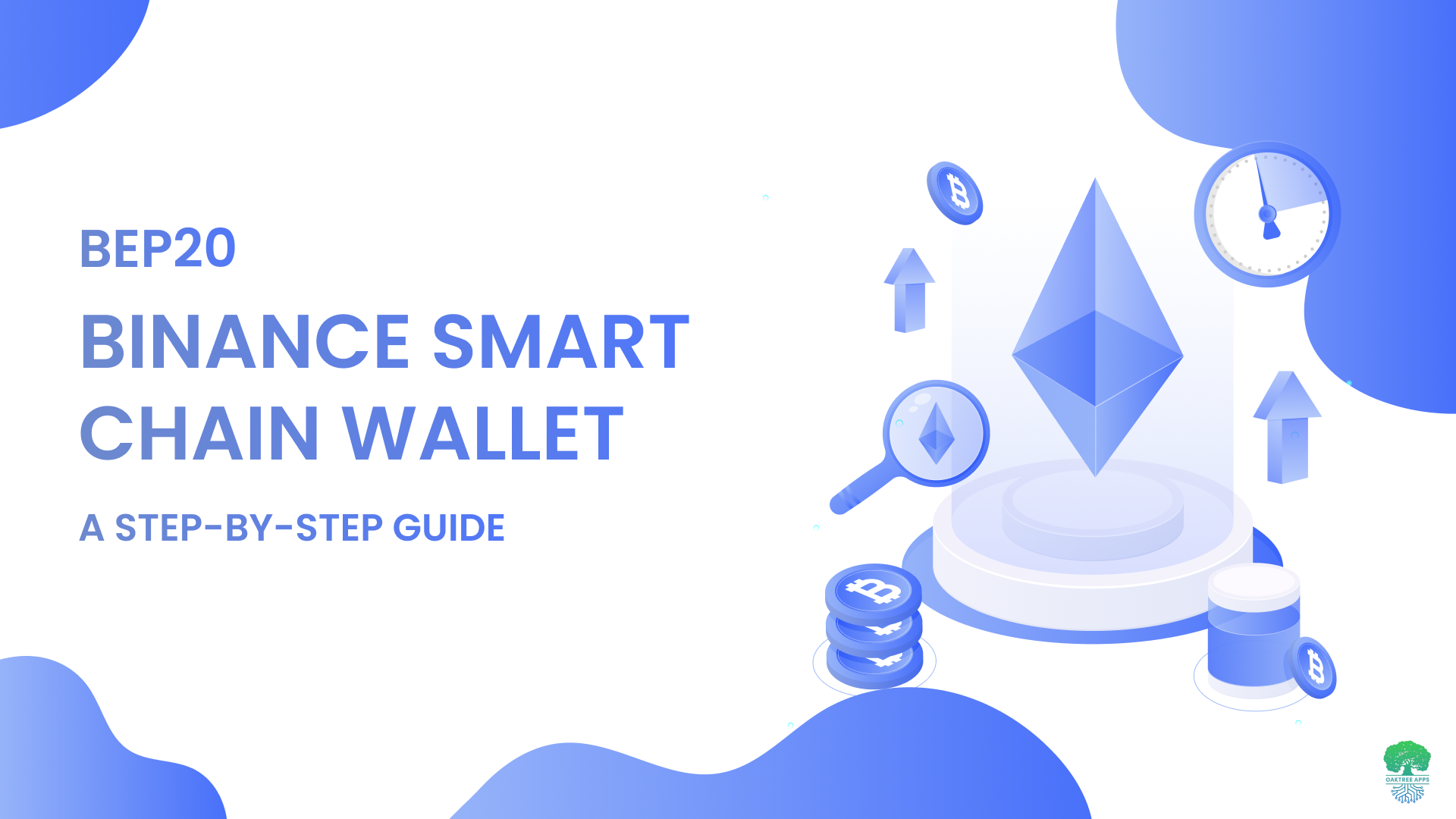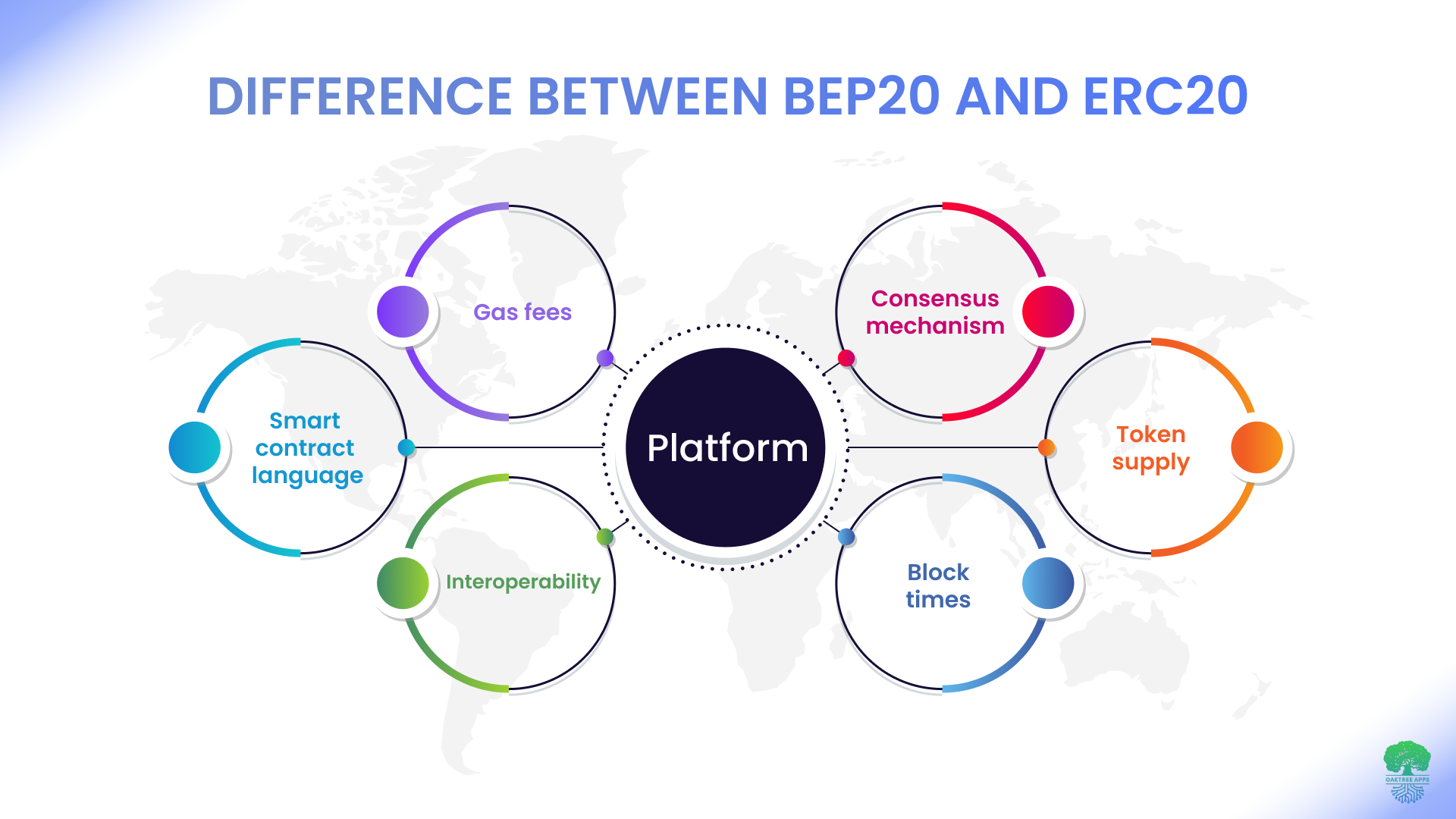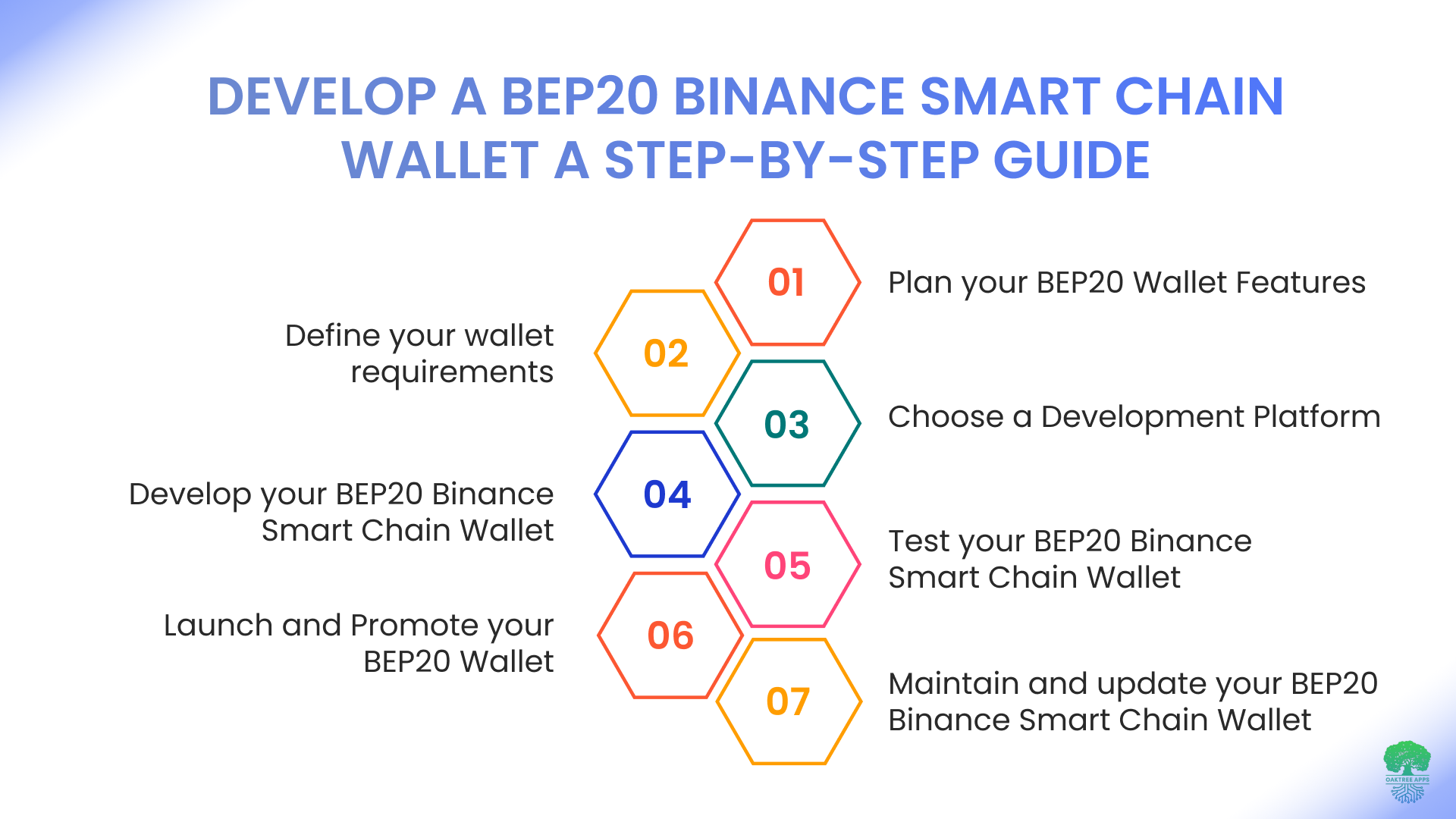May 18 2023

As blockchain technology continues to revolutionize the world of finance, the demand for secure and user-friendly wallets has grown exponentially. Among the various blockchain networks, the Binance Smart Chain (BSC) has emerged as a popular choice for developers and users alike. BSC has its own unique token standard, BEP20, which enables the creation and management of tokens on the blockchain network.
Creating a BEP20 Binance Smart Chain wallet is essential for those looking to transact with BEP20 tokens on the Binance Smart Chain. Creating a BEP20 wallet involves several technical steps, including choosing the appropriate development tools, generating a smart contract, and integrating the necessary features to ensure maximum security and ease of use.
At Oaktree Apps, we specialize in developing top-of-the-line BEP20 Binance Smart Chain wallets that provide users with a seamless and secure experience. Our expert team of developers is well-versed in the latest technologies and best practices, ensuring that our wallets are optimized for performance, reliability, and security. So, Let's Dive In!
Understanding BEP20 Tokens
BEP20 tokens are built using the BEP20 token standard, like the ERC20 token standard used on the Ethereum network. BEP20 tokens are designed to be compatible with Ethereum wallets and exchanges, making it easy for developers to migrate their projects from Ethereum to the Binance Smart Chain. The BEP20 token standard allows for the creation of smart contracts, which enable developers to create decentralized applications (DApps) that can interact with the Binance Smart Chain.
BEP2 vs BEP20
BEP2 and BEP20 are both token standards used on the Binance Chain and Binance Smart Chain, respectively. BEP2 tokens are tokens that are issued on the Binance Chain, which is a blockchain that is separate from the Binance Smart Chain. BEP2 tokens can only be traded on the Binance DEX (decentralized exchange) and are not compatible with the Ethereum network. On the other hand, BEP20 tokens are issued on the Binance Smart Chain, which is fully compatible with the Ethereum network. BEP20 tokens can be easily transferred and traded on Ethereum and Binance Smart Chain, making them more versatile and accessible than BEP2 tokens.

Difference Between BEP20 and ERC20
BEP20 and ERC20 are token standards used to create and manage tokens on blockchain platforms, specifically Binance Smart Chain and Ethereum.
Here are some key differences between BEP20 and ERC20:
Platform: BEP20 is used on the Binance Smart Chain, while ERC20 is used on the Ethereum network.
Gas fees: While both standards use gas fees to execute transactions, the difference is that BEP20 uses Binance Coin (BNB) as its gas fee, while ERC20 uses Ether (ETH).
Smart contract language: ERC20 tokens are built using the Solidity programming language, while BEP20 tokens are built using a modified version of Solidity called Vyper.
Interoperability: While ERC20 tokens can only be used on the Ethereum network, BEP20 tokens can be used on the Binance Smart Chain network as well as other blockchains that support the BEP20 standard.
Block times: The average block time for Ethereum is around 13 seconds, while the Binance Smart Chain has a block time of around 3 seconds. This means transactions using BEP20 tokens are generally faster than those using ERC20 tokens.
Token supply: ERC20 tokens have a maximum supply limit of 2^256-1, while BEP20 tokens have a maximum supply limit of 2^128-1.
Consensus mechanism: Ethereum used Proof-of-Work (PoW) consensus mechanism for an extended period but switched to Proof-of-Stake (PoS) consensus mechanism in 2022, On the other hand, Binance Smart Chain has utilized the Proof-of-Stake (PoS) consensus mechanism since its inception. As a result, Binance Smart Chain's design from the beginning as a PoS blockchain can potentially make it more energy-efficient and faster compared to Ethereum's network.
Application of BEP20 Token Standard
BEP20 tokens can be used to represent a variety of digital assets, including utility tokens, stablecoins, and security tokens. This flexibility allows developers to create a wide range of blockchain-based applications on the Binance Smart Chain, including decentralized exchanges, lending platforms, and more.
In addition to these applications, BEP20 tokens can also be used to create "stablecoins," which are tokens pegged to the value of another asset. For example, a Peggy coin could be created to represent the value of the US dollar or gold. These Peggy coins can be traded and exchanged on the Binance Smart Chain like any other BEP20 token.
Discover the Endless Possibilities of the BEP20 Token Standard!
Connect with our experts today and revolutionize your tokenization journey
Contact UsThere are also several use cases for the BEP20 token standard on the Binance Smart Chain, including:
Payment: BEP20 tokens can be used as a form of payment for goods and services on platforms that accept them as a mode of payment.
Staking and Liquidity Pools: BEP20 tokens can be used for staking, providing liquidity in liquidity pools, and participating in yield farming on Binance Smart Chain-based decentralized exchanges (DEXs) such as PancakeSwap and BakerySwap.
Governance: BEP20 tokens can be used to vote on proposals, changes, and upgrades to decentralized autonomous organizations (DAOs) and other blockchain-based protocols that rely on community governance.
Fundraising: BEP20 tokens can be used for fundraising purposes through Initial Coin Offerings (ICOs) and Initial Decentralized Offerings (IDOs), which allow investors to buy tokens in exchange for other cryptocurrencies.
When performing transactions with BEP20 tokens, Binance Coin (BNB) is used to pay the gas fees instead of Ethereum (ETH), used on the Ethereum platform.

Develop a BEP20 Binance Smart Chain Wallet a Step-by-Step Guide
Once you have developed a clear idea about the BEP20 token standard, you can follow the steps below to develop your BEP20 Binance Smart Chain Wallet.
Step 1: Plan your BEP20 Wallet Features
The next step is to determine the features and functionalities that your BEP20 Binance Smart Chain Wallet should have. This includes the ability to send and receive BEP20 tokens, view transaction history, check wallet balance, and more. It is also important to ensure your wallet is secure, user-friendly, and compatible with different devices.
Step 2: Define your wallet requirements
Determine the type of wallet you want to build and the features you need to include. There are several types of wallets, including web, mobile, and hardware wallets. You may also want to consider adding additional features like two-factor authentication, biometric authentication, or cold storage options.
Step 3: Choose a Development Platform
To develop a BEP20 Binance Smart Chain Wallet, you need to choose a development platform that supports the Binance Smart Chain and BEP20 Token Standard. There are several development platforms available, including Ethereum Remix, Truffle, and Binance Smart Chain Studio. These platforms provide tools and resources for developing and testing your wallet.
Step 4: Develop your BEP20 Binance Smart Chain Wallet
Now it's time to start developing your wallet. You'll need to create a user interface (UI) that allows users to interact with the wallet, send and receive BEP20 tokens, and view their transaction history. You'll also need to develop the smart contract that manages the user's BEP20 tokens and allows them to interact with the Binance Smart Chain network.
Step 5: Test your BEP20 Binance Smart Chain Wallet
Before you deploy your BEP20 Binance Smart Chain Wallet, it's crucial to thoroughly test it to ensure that it functions correctly and is secure. Use tools like Ganache, Remix, and Truffle to assess your wallet on a local blockchain before deploying it to the Binance Smart Chain network. Once you've tested your wallet and are confident it's functioning correctly, you can deploy it to the Binance Smart Chain network.
Step 6: Launch and Promote your BEP20 Wallet
After testing and refining your BEP20 Binance Smart Chain Wallet, the last step is to launch and promote it. You can launch your wallet on the Binance Smart Chain network and make it available to users. It is also important to promote your wallet through various channels, such as social media, forums, and partnerships, to attract users and build a community around your wallet.
Step 7: Maintain and update your BEP20 Binance Smart Chain Wallet
After you've deployed your BEP20 Binance Smart Chain Wallet, you'll need to maintain and update it regularly. This includes fixing bugs, adding new features, and ensuring the wallet is secure and updated with the latest security standards.
Unlock the Power of BEP20 Binance Smart Chain Wallets
Connect with our experts for personalized assistance
Talk to Our Experts Today!Setting up a BEP20 Binance Smart Chain Wallet
Download and install a BEP20 Binance Smart Chain Wallet: You can choose from a variety of wallet options, such as MetaMask, Trust Wallet, and Binance Chain Wallet, among others.
Create a new wallet or import an existing one: If you are creating a new one, follow the instructions to set up your account. This typically involves choosing a strong password, backing up your seed phrase, and verifying your email address. If importing an existing wallet, you will need to enter your private key or seed phrase.
Importance of backing up your wallet seed phrase: Your wallet seed phrase is a string of words that acts as a backup for your private key. It is essential to back up your seed phrase in a safe place, such as a hardware wallet or a piece of paper stored in a secure location.
Adding BEP20 Tokens to your Binance Smart Chain Wallet
Download and install a BEP20 Binance Smart Chain wallet like Trust Wallet or Metamask. Once you have set up your wallet, you can follow these steps to add BEP20 Tokens:
Open your Binance Smart Chain wallet and navigate to the "Assets" tab.
Click on the "Add Token" button.
Enter the contract address of the BEP20 token that you want to add. One way is to search for them on a blockchain explorer like BscScan. Another way is to check the token's website or social media channels for information on how to acquire the token. You can also find BEP20 tokens on decentralized exchanges (DEXs) like PancakeSwap, BakerySwap, and Venus. Centralized exchanges like Binance and KuCoin also support BEP20 tokens.
Add the token to your wallet: You will need to click on the "Add Token" or "Custom Token" button and enter the contract address, token symbol, and decimal places.
Enter the token symbol and decimals. The token symbol is usually a short abbreviation of the token's name (e.g., ETH for Ethereum). Decimals refer to the number of decimal places the token uses to display its value.
Click on "Add" to complete the process.
Once the token is added to your wallet, you can view your balance and transfer it to other wallets.
Wait for the token to appear in your wallet: Once you have added the token, it may take some time for it to appear in your wallet. Be patient and check back after a few minutes.
Before purchasing any BEP20 token, it is important to research and ensure that the token is legitimate and has a real-world use case.
Sending and Receiving BEP20 Tokens:
To send and receive BEP20 tokens, you need to follow these steps:
Open your Binance Smart Chain wallet and navigate to the "Assets" tab.
Click on the BEP20 token that you want to send.
Click on the "send" button in your wallet: This will open a form to enter the recipient's address, the number of tokens you want to send, and any additional notes.
Verify the transaction details: Before sending the tokens, it is important to verify that the recipient's address is correct and that you are sending the correct token amount.
Confirm the transaction: Once you have verified the transaction details, click the "confirm" button to send the tokens. The transaction will then be broadcasted to the Binance Smart Chain network for confirmation.
Click on the "Send" button to initiate the transaction.
When receiving BEP20 Tokens, you will need to provide the sender with your wallet address, which you can find in your wallet. Double-check the address to ensure that you are providing the correct one.
Once the tokens have been sent to your wallet, you should see them in your wallet balance. The transaction may take some time to be confirmed, so be patient and check back after a few minutes.
It is important to note that when sending BEP20 tokens, you will need to have a small amount of Binance Smart Chain (BNB) in your wallet to cover transaction fees.
In conclusion, having a BEP20 Binance Smart Chain Wallet is essential for anyone looking to participate in the DeFi ecosystem on Binance Smart Chain. With its fast transaction speeds, low gas fees, and growing DeFi activity, the Binance Smart Chain is quickly becoming a leading player in the cryptocurrency world.
Creating a BEP20 Binance Smart Chain Wallet requires technical expertise and knowledge of blockchain app development. If you are unfamiliar with blockchain development, it is recommended to seek the help of a professional development company with expertise in creating smart chain wallets like Oaktree Apps. They can provide end-to-end solutions, from planning and development to testing and deployment, to help you create a secure and user-friendly BEP20 Binance Smart Chain Wallet.
FAQs
Several Binance Smart Chain wallets are available, each with advantages and disadvantages. Some popular options include Trust Wallet, Metamask, and Ledger. The best wallet for you will depend on your individual needs and preferences.
The Binance Smart Chain BEP20 address is the unique identifier for your wallet on the Binance Smart Chain. It can be used to send and receive BEP20 tokens. Your address can typically be found in your wallet settings or by logging into your wallet provider's website.
Your BEP20 wallet address is a unique identifier for sending and receiving BEP20 tokens. To find your BEP20 wallet address, open your wallet and look for the "Receive" or "Deposit" button. Clicking on this button will display your wallet address, usually a long string of characters.
Yes, you can withdraw BEP20 tokens from Binance. Log into your Binance account, go to the "Wallet" section, and select "Withdraw." Next, you need to choose BEP20 as the withdrawal network and enter your BEP20 wallet address. Finally, enter the amount of BEP20 tokens you wish to withdraw and confirm the transaction.
No. BNB is a native cryptocurrency of the Binance exchange, while BEP20 is a token standard used to create tokens on the Binance Smart Chain. However, BNB is one of the most popular BEP20 tokens, and it is used for various purposes on the Binance Smart Chain, such as paying transaction fees and participating in token sales.

